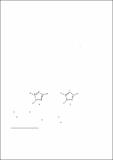Por favor, use este identificador para citar o enlazar a este item:
http://hdl.handle.net/10261/56538COMPARTIR / EXPORTAR:
 SHARE SHARE
 CORE
BASE CORE
BASE
|
|
| Visualizar otros formatos: MARC | Dublin Core | RDF | ORE | MODS | METS | DIDL | DATACITE | |

| Campo DC | Valor | Lengua/Idioma |
|---|---|---|
| dc.contributor.author | Claramunt, Rosa M. | - |
| dc.contributor.author | López, Concepción | - |
| dc.contributor.author | Schmidpeter, A. | - |
| dc.contributor.author | Willhalm, A. | - |
| dc.contributor.author | Elguero, José | - |
| dc.contributor.author | Alkorta, Ibon | - |
| dc.date.accessioned | 2012-09-21T09:45:17Z | - |
| dc.date.available | 2012-09-21T09:45:17Z | - |
| dc.date.issued | 2001 | - |
| dc.identifier | issn: 0712-4813 | - |
| dc.identifier.citation | Spectroscopy 15(1): 27-32 (2001) | - |
| dc.identifier.uri | http://hdl.handle.net/10261/56538 | - |
| dc.description.abstract | The solid state 13C and 15N CPMAS NMR spectra of 3,5-di-tert-butyl-1,2,4-diazaphosphole 4 and 3,5-diphenyl-1,2,4-diazaphosphole 5 have been recorded. The X-ray structure of the first compound was already known (it is a cyclic dimer with localized N-H protons) while the structure of the second cannot be determined due to the difficulty to grow suitable single crystals. NMR results pointed out that 4 is a >classical> compound while 5 is probably a tetramer showing Intermolecular Solid-State Proton Transfer (ISSPT). GIAO/ab initio calculations have been carried out to estimate the absolute 1H, 13C and 15N shieldings. The agreement with the experimental chemical shifts is good enough to assign the signals of carbons C-3 and C-5. | - |
| dc.description.sponsorship | This work has been financially supported by the Spanish DGI/MCT (project numbers PB96-0001-C03 and BQU 2000-0252) and to the “Comunidad de Madrid” (project number 07N/0001/1999) of Spain. | - |
| dc.language.iso | eng | - |
| dc.publisher | IOS Press | - |
| dc.relation | http://dx.doi.org/10.1155/2001/475243 | - |
| dc.relation.isversionof | Publisher's version | - |
| dc.rights | openAccess | - |
| dc.title | 13C and 15N NMR shieldings of 1,2,4-diazaphospholes in the solid state and in solution | - |
| dc.type | artículo | - |
| dc.identifier.doi | 10.1155/2001/475243 | - |
| dc.date.updated | 2012-09-21T09:45:17Z | - |
| dc.description.version | Peer Reviewed | - |
| dc.rights.license | http://creativecommons.org/licenses/by/3.0/ | - |
| dc.contributor.funder | Comunidad de Madrid | - |
| dc.contributor.funder | Ministerio de Ciencia y Tecnología (España) | - |
| dc.relation.csic | Sí | - |
| dc.identifier.funder | http://dx.doi.org/10.13039/501100006280 | es_ES |
| dc.identifier.funder | http://dx.doi.org/10.13039/100012818 | es_ES |
| dc.type.coar | http://purl.org/coar/resource_type/c_6501 | es_ES |
| item.openairetype | artículo | - |
| item.grantfulltext | open | - |
| item.cerifentitytype | Publications | - |
| item.openairecristype | http://purl.org/coar/resource_type/c_18cf | - |
| item.fulltext | With Fulltext | - |
| item.languageiso639-1 | en | - |
| Aparece en las colecciones: | (IQM) Artículos | |
Ficheros en este ítem:
| Fichero | Descripción | Tamaño | Formato | |
|---|---|---|---|---|
| solid_state_Claramunt.pdf | 1,25 MB | Adobe PDF |  Visualizar/Abrir |
CORE Recommender
SCOPUSTM
Citations
6
checked on 13-abr-2024
WEB OF SCIENCETM
Citations
10
checked on 26-feb-2024
Page view(s)
429
checked on 19-abr-2024
Download(s)
222
checked on 19-abr-2024
Google ScholarTM
Check
Altmetric
Altmetric
Este item está licenciado bajo una Licencia Creative Commons

